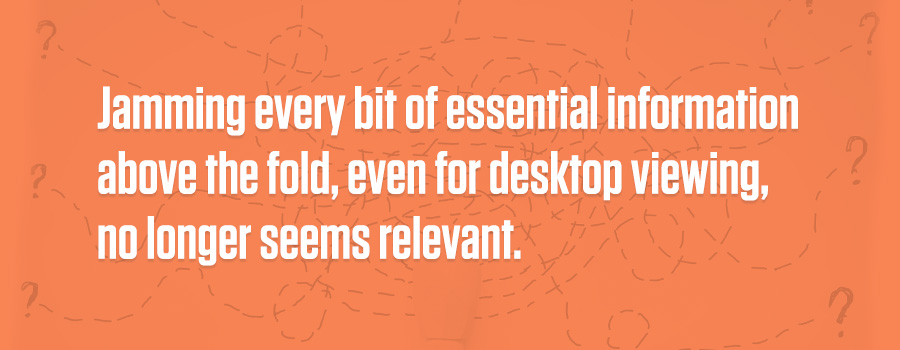
The Fold Is Dead
“Above the fold” and “below the fold” are two design terms that have become increasingly irrelevant to web design.
The origins of “fold” come from print media, newspapers in particular. Headlines and leads “above the fold” were calculated to grab people’s attention and sell papers on the street or at newsstands.
In the early days of the Web, when screen sizes were more or less uniform, the concept of the fold carried over. Companies tried to jam as much alluring information and conversion elements as possible above the fold, based on the assumption users would not bother to scroll down to find the information. For many business websites, this assumption proved to be true; the development of website analytics confirmed user behavior patterns that conformed to the theory.
Today, however, everything has changed. Considering the wide range of desktop monitors and resolutions, along with the explosion in Internet use on smartphones and tablets, screen sizes are anything but uniform. One person’s above-the-fold view is another person’s whole page view!
To adapt to this wide range of screen sizes, web designers often use responsive design techniques, to create a page view on mobile devices that is substantially different in appearance from the desktop view. Responsive design facilitates scrolling on mobile phones, something users seem to actually prefer.

Desktop users, we should remember, also figure to be mobile users. As such, they are accustomed to scrolling. Even in desktop view, the idea of scrolling for more information has taken root; jamming every bit of essential information above the fold, even for desktop viewing, no longer seems relevant.
Implications of the Dead Fold
Content rules all: The key is to produce smart, digestible content that gives users a reason to want to see more.
Along these lines, a storytelling approach works very well, since a storyline gives content a vertical, hierarchical structure that lends itself perfectly to a scrolling mentality. Not only does storytelling fit modern technology, it brings back an ancient form of expression that worked well for centuries before TV and “interruption advertising” temporarily derailed it.
Bottom line: Give users a reason to want to see more rather than forcing all the information on them at once. This approach to web design will produce conversions and sales leads, whereas the old above-the-fold method will produce only confusion and lost opportunities.




